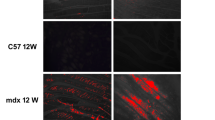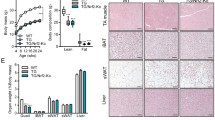Abstract
Skeletal muscle fibers are classified as slow-twitch and fast-twitch fibers, which have different reactive oxygen species (ROS) metabolism and mitochondrial biogenesis. Recently, Attractin (Atrn), which encodes secreted (sAtrn) and transmembrane (mAtrn)-type proteins, has been shown to be involved in free radical scavenging. Although Atrn has been found in skeletal muscle, little is known about the expression levels and function of Atrn in each muscle fiber type. Therefore, we investigate sAtrn and mAtrn expression levels in the slow-twitch soleus (sol) and fast-twitch extensor digitorum longus (EDL) muscles as well as the morphology and expression levels of antioxidant enzymes and functional mitochondrial markers using Atrn-deficient muscles. Both types of Atrn were expressed in the sol and EDL. mAtrn was mainly expressed in the adult sol, whereas sAtrn expression levels did not differ between muscle types. Moreover, mAtrn in the sol was abundantly localized in the subsarcolemmal area, especially in the myoplasm near mitochondria. Atrn-deficient Zitter rats showed muscle fiber atrophy, myofibril misalignment, mitochondrial swelling and vacuolation in the sol but not EDL. Furthermore, the Atrn-deficient sol exhibited a marked reduction in antioxidant enzyme SOD1, GPx1, catalase and Prx6 and mitochondrial functional protein, UCP2, expression. Even Atrn-deficient EDL showed a significant reduction in Prx3, Prx6, UCP2 and UCP3 expression. These data indicate that Atrn-deficiency disturbs ROS metabolism in skeletal muscles. In particular, mAtrn is involved in metabolism in the slow-twitch sol muscle and mAtrn-deficiency may cause ROS imbalance, resulting in morphological abnormalities in the muscle.





Similar content being viewed by others
References
Abrigo J, Elorza AA, Riedel CA, Vilos C, Simon F, Cabrera D, Estrada L, Cabello-Verrugio C (2018) Role of oxidative stress as key regulator of muscle wasting during cachexia. Oxid Med Cell Longev 2018:2063179
Avila-Polo R, Malfatti E, Lornage X, Cheraud C, Nelson I, Nectoux J, Bohm J, Schneider R, Hedberg-Oldfors C, Eymard B, Monges S, Lubieniecki F, Brochier G, Thao Bui M, Madelaine A, Labasse C, Beuvin M, Lacene E, Boland A, Deleuze JF, Thompson J, Richard I, Taratuto AL, Udd B, Leturcq F, Bonne G, Oldfors A, Laporte J, Romero NB (2018) Loss of sarcomeric scaffolding as a common baseline histopathologic lesion in titin-related myopathies. J Neuropathol Exp Neurol 77:1101–1114
Boss O, Samec S, Dulloo A, Seydoux J, Muzzin P, Giacobino JP (1997) Tissue-dependent upregulation of rat uncoupling protein-2 expression in response to fasting or cold. FEBS Lett 412:111–114
Da Silva-Azevedo L, Jahne S, Hoffmann C, Stalder D, Heller M, Pries AR, Zakrzewicz A, Baum O (2009) Up-regulation of the peroxiredoxin-6 related metabolism of reactive oxygen species in skeletal muscle of mice lacking neuronal nitric oxide synthase. J Physiol 587:655–668
Dammeyer P, Arner ES (2011) Human Protein Atlas of redox systems - what can be learnt? Biochim Biophys Acta 1810:111–138
Duke-Cohan JS, Gu J, McLaughlin DF, Xu Y, Freeman GJ, Schlossman SF (1998) Attractin (DPPT-L), a member of the CUB family of cell adhesion and guidance proteins, is secreted by activated human T lymphocytes and modulates immune cell interactions. Proc Natl Acad Sci U S A 95:11336–11341
Ehara A, Sakakibara S, Ueda S (2016) The Role of Attractin in Neurodegeneration Caused by Oxidative Stress. Free Radicals and Diseases, Ahmad, R (Ed ):InTech, https://doi.org/10.5772/63330. Available from: https://www.intechopen.com/books/free-radicals-and-diseases/the-role-of-attractin-in-neurodegeneration-caused-by-oxidative-stress
Ehara A, Nakadate K, Sugimoto H, Yoshimoto K, Ueda S (2018) Role of neuronal nitric oxide synthase in slowly progressive dopaminergic neurodegeneration in the Zitter rat. Nitric Oxide 78:41–50
Gomi H, Ueno I, Yamanouchi K (1994) Antioxidant enzymes in the brain of zitter rats: abnormal metabolism of oxygen species and its relevance to pathogenic changes in the brain of zitter rats with genetic spongiform encephalopathy. Brain Res 653:66–72
Hesselink MK, Keizer HA, Borghouts LB, Schaart G, Kornips CF, Slieker LJ, Sloop KW, Saris WH, Schrauwen P (2001) Protein expression of UCP3 differs between human type 1, type 2a, and type 2b fibers. FASEB J 15:1071–1073
Hirabara SM, Silveira LR, Alberici LC, Leandro CV, Lambertucci RH, Polimeno GC, Cury Boaventura MF, Procopio J, Vercesi AE, Curi R (2006) Acute effect of fatty acids on metabolism and mitochondrial coupling in skeletal muscle. Biochim Biophys Acta 1757:57–66
Kuramoto T, Kitada K, Inui T, Sasaki Y, Ito K, Hase T, Kawagachi S, Ogawa Y, Nakao K, Barsh GS, Nagao M, Ushijima T, Serikawa T (2001) Attractin/mahogany/zitter plays a critical role in myelination of the central nervous system. Proc Natl Acad Sci U S A 98:559–564
Lee KP, Shin YJ, Cho SC, Lee SM, Bahn YJ, Kim JY, Kwon ES, Jeong DY, Park SC, Rhee SG, Woo HA, Kwon KS (2014) Peroxiredoxin 3 has a crucial role in the contractile function of skeletal muscle by regulating mitochondrial homeostasis. Free Radic Biol Med 77:298–306
Loureiro AC, do Rego-Monteiro IC, Louzada RA, Ortenzi VH, de Aguiar AP, de Abreu ES, Cavalcanti-de-Albuquerque JP, Hecht F, de Oliveira AC, Ceccatto VM, Fortunato RS, Carvalho DP, (2016) Differential expression of NADPH oxidases depends on skeletal muscle fiber type in rats. Oxid Med Cell Longev 2016:6738701
Muto Y, Sato K (2003) Pivotal role of attractin in cell survival under oxidative stress in the zitter rat brain with genetic spongiform encephalopathy. Brain Res Mol Brain Res 111:111–122
Nakadate K, Noda T, Sakakibara S, Kumamoto K, Matsuura T, Joyce JN, Ueda S (2006) Progressive dopaminergic neurodegeneration of substantia nigra in the zitter mutant rat. Acta Neuropathol 112:64–73
Nakadate K, Sakakibara S, Ueda S (2008) Attractin/mahogany protein expression in the rodent central nervous system. J Comp Neurol 508:94–111
Nikawa T, Nakao R, Asanoma Y, Hayashi R, Furochi H, Hirasaka K, Kishi K (2006) A skeletal muscle-derived secretory protein, attractin, upregulates UCP-2 expression in mouse 3T3-L1 adipocytes. Biol Sci Space 20:33–39
Oh-Ishi S, Kizaki T, Yamashita H, Nagata N, Suzuki K, Taniguchi N, Ohno H (1995) Alterations of superoxide dismutase iso-enzyme activity, content, and mRNA expression with aging in rat skeletal muscle. Mech Ageing Dev 84:65–76
Paz J, Yao H, Lim HS, Lu XY, Zhang W (2007) The neuroprotective role of attractin in neurodegeneration. Neurobiol Aging 28:1446–1456
Picard M, Hepple RT, Burelle Y (2012) Mitochondrial functional specialization in glycolytic and oxidative muscle fibers: tailoring the organelle for optimal function. Am J Physiol Cell Physiol 302:C629–C641
Pierobon-Bormioli S, Sartore S, Libera LD, Vitadello M, Schiaffino S (1981) “Fast” isomyosins and fiber types in mammalian skeletal muscle. J Histochem Cytochem 29:1179–1188
Powers SK, Jackson MJ (2008) Exercise-induced oxidative stress: cellular mechanisms and impact on muscle force production. Physiol Rev 88:1243–1276
Powers SK, Ji LL, Kavazis AN, Jackson MJ (2011) Reactive oxygen species: impact on skeletal muscle. Compr Physiol 1:941–969
Rehm S, Mehraein P, Anzil AP, Deerberg F (1982) A new rat mutant with defective overhairs and spongy degeneration of the central nervous system: Clinical and pathologic studies. Lab Anim Sci 32:70–73
Rhee SG, Chae HZ, Kim K (2005) Peroxiredoxins: A historical overview and speculative preview of novel mechanisms and emerging concepts in cell signaling. Free Radic Biol Med 38:1543–1552
Schiaffino S, Hanzlikova V, Pierobon S (1970) Relations between structure and function in rat skeletal muscle fibers. J Cell Biol 47:107–119
Selcen D, Engel AG (2004) Mutations in myotilin cause myofibrillar myopathy. Neurology 62:1363–1371
Tang W, Duke-Cohan JS (2002) Human secreted attractin disrupts neurite formation in differentiating cortical neural cells in vitro. J Neuropathol Exp Neurol 61:767–777
Tang W, Gunn TM, McLaughlin DF, Barsh GS, Schlossman SF, Duke-Cohan JS (2000) Secreted and membrane attractin result from alternative splicing of the human ATRN gene. Proc Natl Acad Sci USA 97:6025–6030
Ueda S, Sakakibara S, Watanabe E, Yoshimoto K, Koibuchi N (2002) Vulnerability of monoaminergic neurons in the brainstem of the zitter rat in oxidative stress. Prog Brain Res 136:293–302
Yamada T, Mishima T, Sakamoto M, Sugiyama M, Matsunaga S, Wada M (2006) Oxidation of myosin heavy chain and reduction in force production in hyperthyroid rat soleus. J Appl Physiol (1985) 100:1520–1526
Acknowledgements
The authors would like to express their gratitude to Mr. Masahiro Takano (Teikyo University Mechanical Factory) for manufacturing the cryomill, Ms. Shukuko Minami for her technical assistance and Ms. Fusae Terauchi for her assistance with manuscript preparation.
Funding
This work was supported by a research grant from Dokkyo Medical University.
Author information
Authors and Affiliations
Corresponding author
Ethics declarations
Ethical approval
All procedures performed involving animals were in accordance with NIH guidelines and approved by the Animal Welfare Committee at Dokkyo University School of Medicine (approval no. 0570).
Conflict of interest
The authors declare that they have no conflict of interest.
Additional information
Publisher’s Note
Springer Nature remains neutral with regard to jurisdictional claims in published maps and institutional affiliations.
Supplementary Information
Below is the link to the electronic supplementary material.
Rights and permissions
About this article
Cite this article
Ehara, A., Taguchi, D., Nakadate, K. et al. Attractin deficiency causes metabolic and morphological abnormalities in slow-twitch muscle. Cell Tissue Res 384, 745–756 (2021). https://doi.org/10.1007/s00441-021-03423-w
Received:
Accepted:
Published:
Issue Date:
DOI: https://doi.org/10.1007/s00441-021-03423-w




